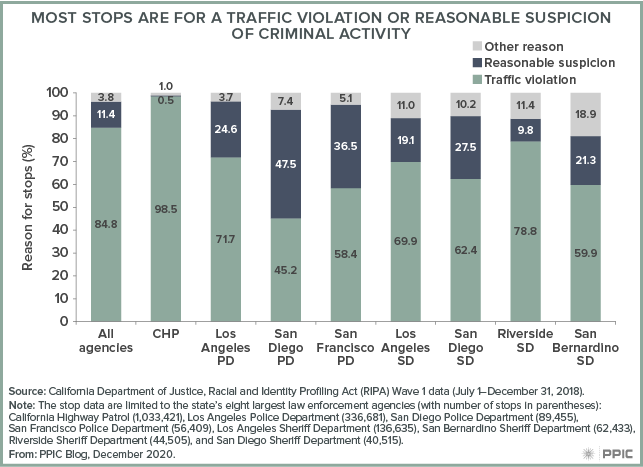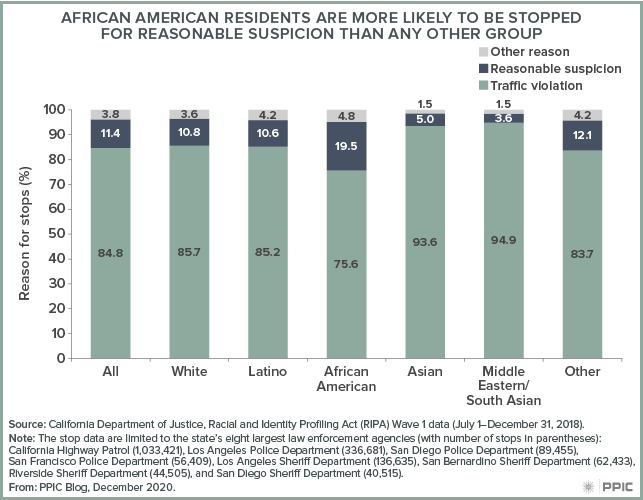The killings of Breonna Taylor and George Floyd—among many others—laid bare the stark racial inequities in our criminal justice system, highlighting the need for reform and better understanding around interactions with law enforcement. Stop data, or data on when officers detain or search someone, from California’s Racial and Identity Profiling Act (RIPA) sheds light on how law enforcement engages with the communities they serve. The latest data for California’s eight largest law enforcement agencies (covering July 1–December 31, 2018) indicate that when officers made stops, the reason varies across race and agency type.
Traffic stops are the most frequent point of contact between law enforcement and the community for these eight agencies—which include the California Highway Patrol (CHP); city police departments in Los Angeles, San Diego, and San Francisco; and sheriff departments in Los Angeles, San Diego, Riverside, and San Bernardino. Nearly 85% of stops are for a traffic violation while about 11% are for reasonable suspicion of criminal activity. Other reasons include an outstanding warrant, being on parole or probation supervision, a consensual encounter (a stop starting without probable cause) resulting in a search, and school or student violations.
CHP, the state’s largest agency, enforces traffic laws on state and county highways. At about 98%, almost all CHP stops are traffic violations—reasonable suspicion is rarely the reason a CHP officer stops an individual (0.5%).
City police departments (PD) patrol and respond to calls within a city, while sheriff departments (SD) respond to rural and unincorporated areas of a county. The majority of stops made by the four largest sheriff departments are traffic infractions, ranging from about 60% for San Bernardino SD to almost 79% for Riverside SD. While almost 72% of Los Angeles PD stops are traffic-related, only 45% of San Diego PD stops are traffic violations—it is the only law enforcement agency with more stops for reasonable suspicion (47.5%) than for traffic violations.

Across these eight law enforcement agencies, racial differences are evident in the reason for a stop. More African American residents than white residents are stopped for reasonable suspicion at all agencies except CHP (2.5% of stops of white residents vs. 0.7% of African Americans) and Los Angeles PD (26.8% white vs. 26.6% African American). Notably, San Diego SD reports that 28.3% of stops with white residents are for reasonable suspicion, while 40.8% of stops with African American residents are for this reason.
About 1 in 10 stops of Latino and white residents are for reasonable suspicion—for African American residents, the rate is 1 in 5. And while about 85% of stops of Latino and white residents are for a traffic violation, roughly 94% of stops with Asian residents are for this reason; about 76% of stops of African American residents are for traffic violations.

African American residents are notably overrepresented in law enforcement stops, and with data showing significant differences across race and ethnicity in reasons for stops, it is clear some racial disparities occur in varying degrees across agencies. Several factors may contribute to these patterns, including racial bias, responsibilities across the type of agency, and priorities in how areas within a jurisdiction are patrolled. Some jurisdictions may employ more intense policing in relatively high crime areas, which may be in communities of color.
Continuing to understand law enforcement behavior, including whether stops led to citations and arrests and whether any use-of-force was applied, can inform discussion around police reform. Pinpointing the areas in policing where disparities exist ultimately can help identify solutions to racial inequities.






